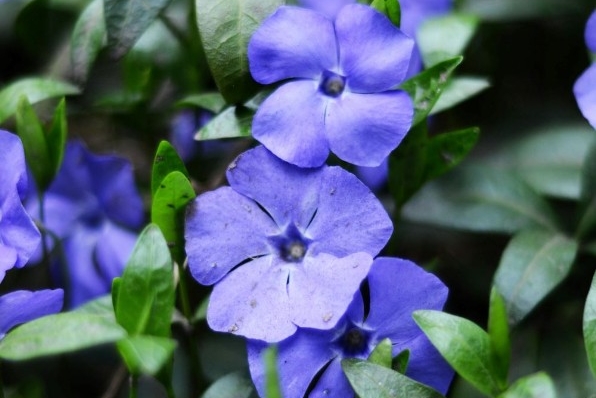
Periwinkle (Vinca minor)
Evergreen groundcover
News posted: 1 January 2024 Post by: Alex Graham
Time to read: ~ minutes, give or take.
In the darkest month of the year, you might well think there is nothing to see in the garden but this a wonderful time for evergreens to shine. They create structure, soften the bare landscape and provide a neat backdrop for other plants throughout the year. Images of plants such as yew, holly, box or bay might now be going through your mind, but don’t forget the hugely important supporting cast of evergreen groundcover. These are naturally low-growing plants that grow quickly, masking bare soil and keeping weeds down. They are ideal for filling awkward spots such as tricky-to-mow areas and slopes, by carpeting the soil and providing low-maintenance interest for your garden year-round.
Not only do these plants look great, but they also have plenty of favourable traits. Many, for example, have fantastic fibrous roots which, as the plants spread, anchor themselves to the ground and help to prevent soil erosion. Their leaves provide a safe habitat for beneficial insects and pollinators that are overwintering. They also diffuse and disperse rainfall and snow before it reaches the ground and act almost as “living mulch”, by providing shade to soil and suppressing weed seed germination.
There are so many to choose from, but I have chosen my top 5 hardworking plants that will help make your garden look abundant and inviting, even in the gloomiest of months! Just remember when you are choosing your plants, to think about the location and how much sun or shade they may get to help them thrive.
Periwinkle (Vinca) is excellent for a steep slope. It grows well in sun or dry shade, so ideal for planting as an understory of other plants and trees. As a bonus, this wonderful plant produces a carpet of delicate flowers from April to September. It’s hard to decide between the traditional azure blue (Vinca minor), dainty white (Vinca minor ‘Gertrude Jekyll’), or warm rich plum tones (Vinca minor ‘Atropurpurea’) - the choice is yours, I do, however, recommend that you choose the smaller Vinca minor varieties rather than the larger Vinca major plants that can become too invasive!
Creeping Thyme - This spreading thyme variety is easy to grow and is excellent for rock gardens, path edging or even an alternative lawn. Perfect for sunny spots, this bee-friendly, edible herb is wonderfully aromatic, producing vast clusters of gorgeous little flowers in a variety of shades from late spring to early summer,
English Ivy (Hedra helix) - This plant can sometimes get a bad reputation, but in the right place it is superb! Using the small roots that grow along its stems, it can cling to almost any surface, so is ideal for planting in tricky, hard to reach places and just letting it get on with it. Ivy prefers shade and organically rich soil (you can encourage growth by enriching the soil with compost). Flowering from September to late November, it is a great source of nectar for many insects. By shearing off the tops of the plant in springtime, you will help to rejuvenate the vines and keep it under control.
Rock Rose (Helianthemum) - This lovely low growing shrub likes a full sun position, the neat pale grey-green evergreen leaves erupt with masses of flowers in midsummer, ranging from cool white to vibrant boiled sweet colours in pinks, oranges, yellows and reds.
Euonymus fortunei’ Emerald Gaity’ - A great ground cover plant for part shade. The waxy green leaves edged with white are useful for brightening up a shady corner. These leaves go on to develop warm pink tones in winter and are an excellent foil for other plants, such as plum-coloured Hellebores.